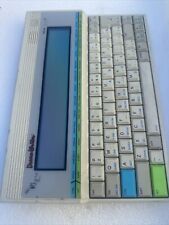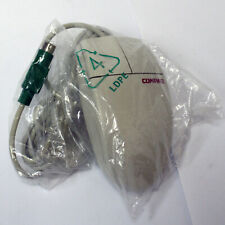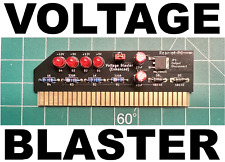-
switch & hub question
I read all the time about configurations like this
router --> switch --> hub--> hub --> workstations
But is this configuration also possible ?
router --> switch --> switch --> switch --> workstations
Am I right about this : the first configuration is slower than the second configuration. Or is the second configuration just nog possible ?
-
Senior Member
registered user
Nope
Your right but it depends on many things....
1st confusion over the difference to a switch/hub
2nd... is a 10MBit switch better than a 100MBit HUB ???
(Answer not for less than 10 PC's)
3rd Is it used for internet only access ??
(if it is then the spped is largely irrelevant unless you have a T3 connection)- if you do I don't wanna know, ill just be jealous....
4th.... until the last couple of years the price difference was larger...
Now it doesn't make sense....
My home network has a 16 port switch connected to a 54Mbit access point
The living room has a 54Mbit access point with built in switch....and this supplies my IP phone and a couple of PC's and XBOX....
However I still trail a cable through for 100mbit Full duplex when I make heavy use of NFS etc....
Its also valid to add a hub at the end to supply a couple of workstations....but given the price difference NOW its just not worth it...
-
Re: Nope
Thank you for the explanation.
The situation is like this
router port 1 --> hub (10mbps) --> 5 workstations
router port 2 --> hub (10mbps) --> 5 workstations
router port 3 --> 1 switch --> 2 hubs (100mbps) --> workstations who need a lot of network performance.
router port 4 --> win2k server
I think I'm going to change the last 2 hubs (those from 100mbps) into 1 switch.
What do you think ?
-
Senior Member
registered user
Depends
I'd need a lot more info to give a definitive answer.....
Changng to a switch won't hurt anything but unless you have a gigabit uplink between the switches the workstations will still be limited to a single 100Mbit connection to router port3 and hence the rest of the network.
Therefore those workstations will have faster communication with each other but the same with everything after the switch on the router side.
Think of a hub as splitting the netowrk bandwidth between the workstations whereas a switch provdies them all with the full bandwidth...
The slowest part of all this will be the switch-switch connection. If this is still 100Mbit then that will be the maximum or weakest link in the chain.
Draw it all out on paper and you'll see what I mean.
Looking at your network it seems to have geographical constraints....
The hubs are used to extend the network
Its not simple to draw up a best solution without knowing geographical constraints and stuff ...(like future expansion)
Soln1: Upgrade the router to a gigabit capable router
then route gigabit to the switch which feeds the high demand workstations....
(this will allow the weak link to be upgraded thus giving 4-5 workstations about 100Mbit) $1500 or so....
Soln 2 : Look at the whole insfrastructure
Soln:2 is future proofing... you might look at wireless etc.... and a gigabit backbone
What does your router actually do though....
Unless the PC's and the win2K server need to be on seperate subnets its unnecassary.
The ultimate question is what do the workstations do/need from the win2K server....
If its SAMBA then is the Win2K workstation capable of serving the files fast enough....
If its only a 100Mbit card in then it isn't becuase it has to share this with the rest.
In fact you will overload it becuase windows is crap at fileserving and it will devleop queues.
Sorry not to be more definititve but from what you say its difficult to give any better advice!!!
-
Administrator
Site Admin-
Re: Nope

Originally Posted by
regus
I think I'm going to change the last 2 hubs (those from 100mbps) into 1 switch.
What do you think ?
It depends on the nature of the traffic and where it is being routed to. If the hub has 4 computers on it that we can call B, C, D and E and they have a lot of traffic between them (say B talking with C while D talks to E), then a switch is a better choice than a hub. If all of the computers are doing moderately high traffic to another computer (which I'll call A) somewhere upstream of this hub, then replacing it with a switch will not help (and in some cases might even have a small negative impact). The diference is that a hub outputs what comes in one port to all of the other ports. A switch is more inteligent and only outputs the data to the required port(s). but if your "workstations who need a lot of network performance" on that hub actually need it to talk to the win2k server you showed (as seems most likely), then don't bother, at least not for this reason.
Since a switch only routes the traffic where it needs to go, it helps make a network a little more secure. You can sniff the traffic on a hub and sometimes learn important information. On a switch you should only see your own traffic so this hack is not as easy. On the other hand, if you're trying to sniff the cable to figure out a low level networking problem, a hub can be an important tool (I keep one around for just that reason).
One other consideration is that a hub can actually be slightly faster than a switch. The switch needs to receive the packet (at least the header) and analize it before it can start sending it out to the proper port. A hub can send the data while it is still coming in. So there is less latency with a hub than a switch. Again, if this matters to you or not depends on the nature of your network and applications, in some cases the extra latency is not the issue (raw throughput is), while in others the latency does matter.
And this all assumes that all of your ethernet connections are 100 mbs and you never have a 10 mbp computer that might need to move to this hub. Since you are running both speeds on the network, having a switch might give you more utility, but it will not improve the network speed unless there is a significant ammount of local traffic between the local computers on those 2 hubs, and that traffic is such that you get a bandwidth gain. Everyone else talking with B, for example, will not buy you an improvement by switching to a switch).
Since router port 3 feeds a switch that only feeds 2 hubs, you might even improve your system if you remove the switch on this port and feed directly to one of the hubs and feed the other hub from that on (assuming that you have an available port on one hub and that the physical wiring requirements support it). This would eliminate the latency of that switch. Or you might swap the switch with one of the hubs (again, very dependent on the traffic requirements of your network).
-
Thanks all for your very detailed reply ! I need some thinking now to decide which solution is the best.
Bart
-
Senior Member
registered user
bart
You need to draw it out.
Put it down, on paper if necassary 
Work out what gets what from where and what bandwidth it needs or is desirable and what else it is connected to.
It all depends on budget vs speed vs cost to maintain vs 'everything outside of the network in a strict sense'
The simplest rule is what is the weakest link.... and how important is it to upgrade. What type of data is being passed and do you need to.
(For instance if the Win2K server is sharing a lot of files being used by UNIX/LINUX workstations then the cheapest option (Captital wise) is to serve this by NFS locally BUT this might be more costly in support and operational costs.
Generally large organisations tend to use a star hub approach .....
One common thing I see a lot is that the data is needed in a technical dept. (This is my job) BUT the global IT dept want to keep it centrally.
This is all well and good if the network is great and they can serve files fast enough and they are on the same floor or on a floor with very good connectivity to yours.
Every router adds latency, even the very expensive ones.
Switches add a little but this is usually pretty small unless your using real time apps.
Also vlans, encryption and tunnels all add latency ...
Also you need to monitor the bandwidth usage and see where the bandwidth is commonly used. We used to have people copy a couple of Gigs of data across the network to their local drive becuase it ran faster.
Of course this paralised the network .... but that was because the network wasn't fast enough to cope.
Nor should it be faster, a PC IDE disk or even a workstation SCSI disk cannot hope to match a proper array. In this case we solved the problem by moving the data to the user.
This is my situation though not yours....
The best thing I can say is to try and work out where the data is being moved to/from and if that can be done more efficiently.
Similar Threads
-
By djarum in forum Networking
Replies: 3
Last Post: 06-27-2005, 05:39 AM
-
By pi8ch in forum Networking
Replies: 2
Last Post: 12-06-2004, 04:30 PM
-
By senorian in forum Hardware & Booting
Replies: 0
Last Post: 04-20-2004, 08:19 PM
-
By bob58 in forum General Support
Replies: 1
Last Post: 03-23-2004, 05:38 PM
-
By efi360 in forum General Support
Replies: 8
Last Post: 08-17-2003, 07:52 AM
 Posting Permissions
Posting Permissions
- You may not post new threads
- You may not post replies
- You may not post attachments
- You may not edit your posts
-
Forum Rules


Vintage Dream Writer NTS 325 Computer Basic Language Notebook “Untested “
$30.00

Vintage Compaq 141649-004 2 Button PS/2 Gray Mouse M-S34 - FAST SHIPPING - NEW
$8.99

Vintage Classic Apple Macintosh System Boot Install Disk Floppy/CD *Pick Version
$10.39

VINTAGE MANUAL IBM / 5340 Volume D Field Service Logics
$74.99

Voltage Blaster (Enhanced) -5V ISA AT ATX Power for Vintage Retro PCs US Seller
$12.95

Vintage Black Microsoft intellimouse Optical USB Wheel Mouse 1.1/1.1a - EXC COND
$28.95

NEW Manufacture OLD STYLE Oval 3 Prong Power Cord HP style 125V 7A 875W Vintage
$39.95

Leather Case Cover for iPad 10.2 9 8 7th Generation Pro iPad Air 1 2 5th 6th 9.7
$16.99

Vintage KLH 2800 Laptop
$150.00

Vintage Comfort Keyboard Systems Ergomagic Mechanical AT/PS2 Keyboard
$149.99



 Reply With Quote
Reply With Quote










